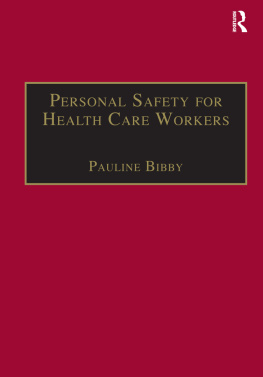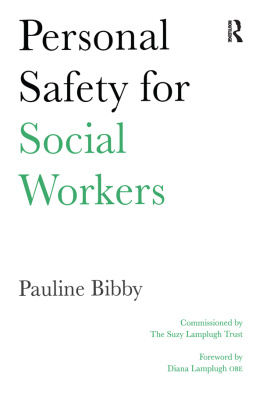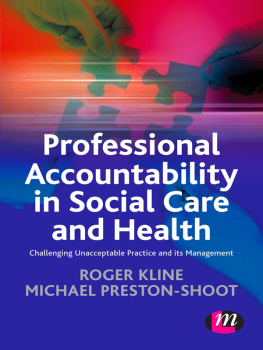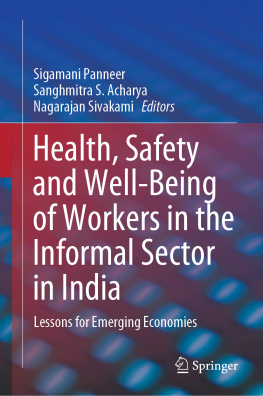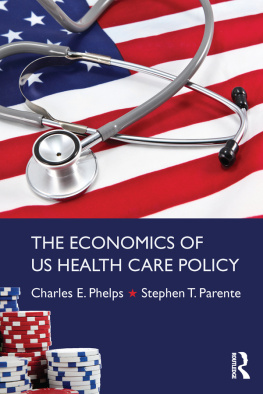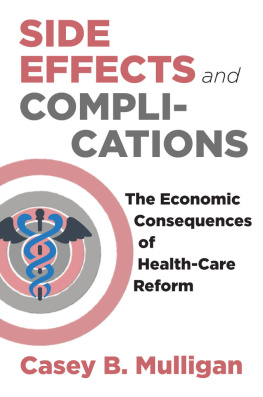First published 1995
by Ashgate Publishing
Published 2016
by Routledge
2 Park Square, Milton Park, Abingdon, Oxon OX14 4RN
711 Third Avenue, New York, NY 10017, USA
Routledge is an imprint of the Taylor & Francis Group, an informa business
Copyright 1995 The Suzy Lamplugh Trust
All rights reserved. No part of this book may be reprinted or reproduced or utilised in any form or by any electronic, mechanical, or other means, now known or hereafter invented, including photocopying and recording, or in any information storage or retrieval system, without permission in writing from the publishers.
Notice:
Product or corporate names may be trademarks or registered trademarks, and are used only for identification and explanation without intent to infringe.
British Library Cataloguing in Publication Data
Personal Safety for Health Care Workers
I. Bibby, Pauline
362.88
ISBN 9781857421965 (pbk)
Library of Congress Catalog Card Number: 95-76035
Transfered to Digital Printing in 2009
by Diana Lamplugh OBE
Suzy left me a legacy. Nothing can take away the inevitable pain of her absence, that unfilled space in our lives which cuts to the quick. Nothing will change the fact that my daughter disappeared one sunny summer's midday while doing her normal work as a negotiator for an estate agency. Now, nearly nine years later, she has been presumed murdered, declared dead and we know we will never see her again. Now we have so many wonderful memories and we also have Suzy's legacy. This has touched many lives, has stayed the course of time and grown beyond any expectations.
It might appear remarkable, if it were not for the fact that her disappearance opened a festering wound which was already there. The problem of aggression and violence in the workplace was a present and growing concern, although at that time mainly unacknowledged or ignored. Gradually the tide of opinion has changed, the law has been redefined, EC directives have tightened up legislation, insurance companies are beginning to bite and the lawyers are responding to the scent of a possible new seam of profitable cases.
Now it is also commonly recognized that the professions are not immune. This has perhaps taken an even bigger leap of understanding. My father was in the law, my husband too was a lawyer who joined the staff of the Law Society. Even after our daughter disappeared I would never have considered that such a respectable profession could have a problem with personal safety.
These past eight years have forced me to think quite differently. With hindsight I realize how shaken my father was when faced with a shotgun when visiting a client in his country home. I now remember the time my father refused to prosecute the man who had deliberately scratched both sides of his car, 'The poor lad felt I let him down in his drink-driving case', he said. I thought of his receptionist tearing her hair out after the umpteenth call from an irate woman complaining about her neighbour and noise nuisance, and the articled clerk who was trapped into a blackmail situation over a property deal. All these incidents fall within the Health and Safety Executive and EC definitions of violence at work, which include verbal and mental abuse, discrimination, harassment, bullying and even ostracism as well as threats, assault and attack.
The night before we launched our manual Training for Personal Safety in the Workplace, I had been with a group of midwives in Cambridgeshire. Although the venue for my talk was in a hospital, most of those present worked in the community. As usual during my presentation we all swapped stories, and the ones I heard impressed me so much that when a journalist from The Times pressed me at the launch to say what kind of work or profession carried with it an element of risk, I did not hesitate to say 'midwifery'. She looked at me as though I was slightly deranged. The piece was never printed, so I took that to mean that her editor agreed with her.
The problem is widespread. Family doctors and their surgery staff are increasingly at the mercy of violent patients who abuse them verbally and physically. Aggressive behaviour by patients or their families is becoming an increasingly common feature of life in general practice. Recent surveys in London and the West Midlands show that more than half of all doctors have been verbally abused. The problem is at its worst in inner cities - 1 in 10 inner London doctors have been physically attacked in the last two years - but suburban and rural practices are not immune. And these statistics do not take into account other staff who are in the front line - the receptionist and the practice nurse. According to the General Medical Services Committee (1994) in their guidelines Combating Violence in General Practice:
This unacceptable behaviour does not have to be tolerated. If doctors fail to take decisive action in the face of actual or threatened violence, they not only do a disservice to themselves, their staff and other colleagues, but they put at risk the mutual trust on which primary care is based. To tolerate abusive or violent behaviour invites the perpetrator to repeat his or her actions. Therefore, the prevention of violent or threatening behaviour is vital to our professionalism.
The problem of aggression and violence at work is not one of gender. The Trust's research shows that 7 out of 10 incidents at work are perpetrated on men. Outside the workplace the majority of assaults and attacks are also on men (for example, 83 per cent of attacks on London Underground are by young men on young men). Most attacks on women are in the home or in a place that is known to them, by people they know, or think they know. Women are in fact very good at defusing and avoiding aggression, verbal as well as physical. Men can often respond to aggression with aggression leading to confrontation, which can end in even more problems.
It is in the interest of employers - not only employees - to reduce violence at work. For employers, violence can lead to low morale and a poor image for the organization, making it difficult to recruit and retain staff. It can also mean extra costs, with absenteeism, higher insurance premiums and compensation payments. PTS (Post-Trauma Syndrome) is now a well-documented and recognized condition which can severely affect the way employees can continue to work, and may result in the need for skilled professional counselling. What is less obvious is that employees suffering such aggression as continuous verbal abuse can suffer considerably from stress-related problems. Quite simply, no employer can afford to turn a blind eye. All employers have a legal duty under Section 2(1) of the Health and Safety at Work etc. Act 1974 to ensure, so far as is reasonably practicable, the health, safety and welfare at work of their employees. This duty extends to protecting employees from violence.
Risk assessment is also an employer's explicit duty under the Management of Health and Safety at Work Regulations 1992. These regulations require that employers undertake a systematic general examination of their work activity and, if there are five or more employees, they must record the significant findings of that assessment. Under these regulations employers need to follow up their risk assessment with appropriate preventative and protective measures and management arrangements (for example, planning, organization, control, monitoring and review). They must give employees adequate information and training to be able to understand the risks and the measures (including procedures, policies etc.) taken to deal with them. Once these have been tried and agreed in consultation with employees and, whenever possible, their union representatives, it is then the employees' responsibility not to put themselves in danger, or their colleagues, or their workplace. Employees who deliberately ignore the procedures and policies for health and safety might be considered negligent should an incident occur. They must also report incidents, problems and shortcomings in arrangements to control risks.

